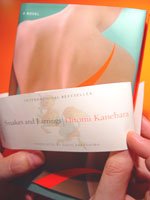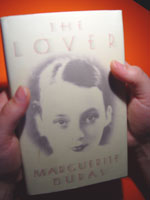The GoodShortNovels.com Review--One Recent Release and One Classic
Erotic Coming-of-Age in Asian Settings--Two Very Short International Bestsellers
SNAKES AND EARRINGS and THE LOVER
Reviewer: Stedman Mays
Recent Release
 SNAKES AND EARRINGS by Hitomi Kanehara. Translated from the Japanese by David Karashima. Dutton, 2005 (originally published in Japanese as HEBI NI PIASU in 2004 by Shueisha, Inc.). Hardcover. 120 pages of very sparsely laid-out text. Estimated length: fewer than 30,000 words.
SNAKES AND EARRINGS by Hitomi Kanehara. Translated from the Japanese by David Karashima. Dutton, 2005 (originally published in Japanese as HEBI NI PIASU in 2004 by Shueisha, Inc.). Hardcover. 120 pages of very sparsely laid-out text. Estimated length: fewer than 30,000 words.
Piercing, cutting, and painting the body are universal practices. Whether it’s something as common as ear piercing or circumcision or cosmetic surgery, or even just clipping your nails or dying your hair or controlling your weight, it all amounts to the same general thing--body modification.
But there are those who practice more exotic forms of body modification, such as elaborate tattooing and piercing of the tongue. In the Japanese novelist Hitomi Kanehara’s SNAKES AND EARRINGS, the counterculture of extreme body alteration and sadomasochistic sex becomes the focus of young people in Tokyo trying to brand themselves and create their own unique identities.
Nineteen-year-old escort and hostess Lui--named for “Louis Vuitton,” she explains--is preoccupied with rebelling against the mainstream consumerist culture she was born into. She’s no political activist, however. She’s much too lackadaisical for that. Her tactic is to drift from one weird situation to the next. Her motto is “Live recklessly and leave nothing behind but ashes in this dark, dull world.” Lui is the narrator, and it is from her nihilistic point of view that we are told the story.
Lui meets the handsome punked-out stud Ama--a series of earrings in his left eyebrow and bottom lip, dyed red hair in a Mohawk cut, wearing a tank top to reveal a tattoo--at a dingy techno club. When she notices his artificially created forked tongue, she immediately knows that she’s found someone who can direct her on the path to body-modification nirvana. They have hot sex at his place, and Ama uses his forked tongue to dazzling “pre- and post-coital” effect, especially when he sucks and massages Lui’s nipples with both sides of it at once. She moves in with Ama and promptly goes to see his friend Shiba--expert piercer, tattoo artist, jewelry vendor, and sadistic bisexual--at his shop “Desire,” where the pain of tattooing and piercing is oddly appealing. For this triangle of characters, the act of violating and altering the body and skin is both self-defining and intensely erotic.
Lui eventually gets a large tattoo of a dragon placed on her back by Shiba, but the story of the book centers around Lui’s piercing of her tongue and her attempts to stretch the hole in her tongue to accommodate bigger and bigger studs. Her goal is to enlarge the hole so that she can slash through the front portion of it completely to make “the final cut,” thus creating a forked tongue of her own. The scenes of tongue mutilation and Lui’s obsessive commentary on the process are among the best parts of the book. I almost found myself rooting for her to reach her goal, even though the idea of piercing and cutting through a person’s tongue in this fashion made me cringe in the novel’s early pages. I was drawn in to a quest for something that initially repulsed me.
The sex scenes are also quite intriguing. Lui’s deadpan recitation of her diverse sexual practices--she’s basically a masochist who does just about anything she’s told--is amusingly blasé. Her passivity is so insistent that it becomes a kind of active passivity, which probably won’t win her a place as a feminist icon. But her nonchalance and seeming detachment are refreshing in that you never feel she has an axe to grind.
The weak point of the book is its sensationalistic murder mystery puzzle, which thankfully doesn’t become overbearing until late in the story. Kanehara doesn’t quite know how to handle the late-breaking grisly crime and its aftermath and the characters’ reactions to it (for fear of exposing the twists of the plot, I won’t go into detail). And the ending feels a bit strained and abrupt. We’re told what happens--or flatly told how a character changes--without allowing us to experience it fully on our own as readers. I like the idea of desire being a dangerous game with unexpected violent consequences, but Kanehara doesn’t quite pull it off.
And yet SNAKES AND EARRINGS is a success in many respects. I can see why it made such a splash in Japan, winning the twenty-year-old author the prestigious Akutagawa Prize (she’s now twenty-two) and many fans throughout the world. Whatever criticisms one might have, SNAKES AND EARRINGS does what it does boldly, and that’s admirable (by the way, I wish the publisher had gone with the translator’s bolder working title, SNAKES AND PIERCINGS, since it captures both the content and the sadomasochistic edginess of the book more aptly--alas). Hitomi Kanehara is a strong voice in the wilderness of overwhelmingly bland and mind-numbing novelists being published today. I look forward to watching her talent evolve.

The first consummated sexual experience is a landmark event in anyone’s life. Losing our virginity is equally loss and gain--a loss of innocence and a gain of experience. We’re never quite the same afterward. The memory of sexual initiation lurks in the psyche like an old friend with whom we never quite lose touch. Whether or not a sustained relationship continues after the original encounter, most of us keep a little part of our heart reserved for that sexual partner, who is the first person we ever made ourselves physically vulnerable to.
Marguerite Duras, in her semiautobiographical novel THE LOVER, uses her real-life memories of her first lover as the starting point for a work of fiction. The unnamed heroine, who is at the tender age of fifteen at the start of the narrative, is a fictionalized version of Duras herself, based on her teenage years when she lived with her mother and two brothers in Indochina (French colonial Vietnam) as down-on-their-luck French expatriates. While on the Mekong ferry on the way to Saigon, the young girl--decked out in a man’s fedora, a sleeveless “almost transparent” silk dress with a very low neck, and gold lamé shoes--meets a mysterious and rich Chinese man in his late twenties, the shiftless opium-smoking heir of a wealthy Chinese dynasty that made its fortune in finance and real estate. He is crossing over in his chauffeured black limousine, elegantly sequestered from the hoi polloi on the ferry boat. Erotic energies seem to swirl around the couple in the scene of their first sighting of each other, and even the river itself pulses with the melting heat of physical desire. As Duras writes, “In the misty sun of the river, the sun of the hot season, the banks have faded away, the river seems to reach to the horizon. It flows quietly, without a sound, like the blood in the body.”
This is “desire at first sight” rather than love at first sight. When they eventually go to the city apartment that the wealthy Chinese man keeps for trysts with his mistresses, the young girl tells him that she wants to be treated as he treats his other women, no more, no less. What follows is one of the great erotic scenes in Western literature. The awkwardness, the hesitation, the clumsiness of undressing, and the strangely satisfying pain of her initial penetration all combine to make her deflowering both brutal and pleasurable, both ecstatic and brooding, both romantically idealized and routine.
The lovers are drawn together because of, not in spite of, their differences--he is rich and she is poor, he is Asian and she is European, he is experienced and she is inexperienced, he is older and she is younger. As their relationship deepens over time, however, the rest of the world tries to drive them apart for these very same differences. And there’s the rub of the story--how their love will be tested not only by each other, but also by their families and by the social norms of the late 1920s and 1930s. (One has to remember that interracial dating during the period was taboo and perceived as flagrantly scandalous.) Duras’s attitude toward her mother and her adversarial elder brother is often angry and bitter, while she reserves a great deal of affection for her younger brother, with whom she seems to forge a bond in the face of her mother’s unconcealed favoritism for the eldest son. Freud would have had a field day with this group.
The movie version of THE LOVER (1992) has good production values and lovely photography, as well as a sense of period ambiance. It’s worth seeing for those reasons. But the script fails to capture the moodiness and emotional volatility of Duras’s book, which is narrated by the elderly Duras looking back on her experiences as a young girl, with many dark digressions on the ravages of aging and how we process memory. I would recommend as an alternative--or as supplementary viewing--the movie HIROSHIMA MON AMOUR (1959), another tale of European-Asian interracial romance. Duras contributed the brilliant script for HIROSHIMA MON AMOUR, which tells the story of a new love affair in the present by intercutting it with memories dramatized as flashbacks, seeming to suggest that how we choose to remember or “disremember” the past is inseparable from who we are now. HIROSHIMA MON AMOUR is widely regarded by film critics as the director Alain Resnais’s masterpiece and one of the best movies of all time.
The book THE LOVER does forcefully what few books do--it charts the changing perspectives of the heart, sometimes with a startling turn of phrase. Not only does Duras dissect the relationship between the two lovers, but she also writes incisively about the young girl’s perceptions of her family, fusing ambivalent emotions with economy and incredible precision. For example, take this sentence about Duras’s mother, a school headmistress, that moves adeptly from love to violent hatred:
“My mother, my love, her incredible ungainliness, with her cotton stockings darned by Dô, in the tropics she still thinks you have to wear stockings to be a lady, a headmistress, her dreadful shapeless dresses, mended by Dô, she’s straight out of her Picardy farm full of female cousins, thinks you ought to wear everything till it’s worn out, that you have to be deserving, her shoes, her shoes are down-at-heel, she walks awkwardly, painfully, her hair’s drawn back tight into a bun like a Chinese woman’s, we’re ashamed of her, I’m ashamed of her in the street outside the school, when she drives up to the school in her old Citroёn B12 everyone looks, but she, she doesn’t notice anything, ever, she ought to be locked up, beaten, killed."
Marguerite Duras can do more in the space of a sentence than most other authors accomplish in an entire novel. And, for all the darkness and bitterness, the ending of THE LOVER leaves you breathless.
For the current edition of the GoodShortNovels.com Review, click here
Copyright 2005 Scribblers House® LLC New York. All rights reserved.